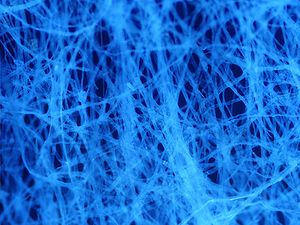
Summary
Autofluorescence is the natural emission of light by biological structures such as mitochondria and lysosomes when they have absorbed light, and is used to distinguish the light originating from artificially added fluorescent markers (fluorophores).[1]

The most commonly observed autofluorescencing molecules are NADPH and flavins; the extracellular matrix can also contribute to autofluorescence because of the intrinsic properties of collagen and elastin.[1]
Generally, proteins containing an increased amount of the amino acids tryptophan, tyrosine, and phenylalanine show some degree of autofluorescence.[2]
Autofluorescence also occurs in non-biological materials found in many papers and textiles. Autofluorescence from U.S. paper money has been demonstrated as a means for discerning counterfeit currency from authentic currency.[3]
Microscopy edit
Autofluorescence can be problematic in fluorescence microscopy. Light-emitting stains (such as fluorescently labelled antibodies) are applied to samples to enable visualisation of specific structures.
Autofluorescence interferes with detection of specific fluorescent signals, especially when the signals of interest are very dim — it causes structures other than those of interest to become visible.
In some microscopes (mainly confocal microscopes), it is possible to make use of different lifetime of the excited states of the added fluorescent markers and the endogenous molecules to exclude most of the autofluorescence.
In a few cases, autofluorescence may actually illuminate the structures of interest, or serve as a useful diagnostic indicator.[1]
For example, cellular autofluorescence can be used as an indicator of cytotoxicity without the need to add fluorescent markers.[4]
The autofluorescence of human skin can be used to measure the level of advanced glycation end-products (AGEs), which are present in higher quantities during several human diseases.[5]
Optical imaging systems that utilize multispectral imaging can reduce signal degradation caused by autofluorescence while adding enhanced multiplexing capabilities.[6]
The super resolution microscopy SPDM revealed autofluorescent cellular objects which are not detectable under conventional fluorescence imaging conditions.[7]
Autofluorescent molecules edit
Molecule Excitation
(nm)Fluorescence
(nm) PeakNAD(P)H 340 450 Z F P [8] Chlorophyll 465–665 673–726 P Collagen 270–370 305–450 Z [8] Retinol 500 Z F P [9] Riboflavin 550 Z F P [9] Cholecalciferol 380–460 Z [9] Folic acid 450 Z F P [9] Pyridoxine 400 Z F P [9] Tyrosine 270 305 Z F P [2] Dityrosine 325 400 Z [2] Excimer-like
aggregate
(collagen)270 360 Z [2] Glycation adduct 370 450 Z [2] Indolamine Z Lipofuscin 410–470 500–695 Z F P [10] Lignin
(a polyphenol)335–488 455–535 P [11] Tryptophan 280 300–350 Z F P Flavin 380–490 520–560 Z F P Melanin 340–400 360–560 Z F P [12]
- Substances luminous in animal tissue are, by taxonomic inclusion, also luminous in human tissue.
See also edit
- Autoluminescence
- Phosphorescence
- Fluorescence in the life sciences
References edit
- ^ a b c Monici, M. (2005). "Cell and tissue autofluorescence research and diagnostic applications". Biotechnology Annual Review. 11: 227–256. doi:10.1016/S1387-2656(05)11007-2. ISBN 9780444519528. PMID 16216779.
- ^ a b c d e Menter, Julian M. (2006). "Temperature dependence of collagen fluorescence". Photochemical & Photobiological Sciences. 5 (4): 403–410. doi:10.1039/b516429j. PMID 16583021. S2CID 34205474.
- ^ Chia, Thomas; Levene, Michael (17 November 2009). "Detection of counterfeit U.S. paper money using intrinsic fluorescence lifetime". Optics Express. 17 (24): 22054–22061. Bibcode:2009OExpr..1722054C. doi:10.1364/OE.17.022054. PMID 19997451.
- ^ Fritzsche, M.; Mandenius, C.F. (September 2010). "Fluorescent cell-based sensing approaches for toxicity testing". Anal Bioanal Chem. 398 (1): 181–191. doi:10.1007/s00216-010-3651-6. PMID 20354845. S2CID 22712460.
- ^ Gerrits, E.G.; Smit, A.J.; Bilo, H.J. (March 2009). "AGEs, autofluorescence and renal function". Nephrol. Dial. Transplant. 24 (3): 710–713. doi:10.1093/ndt/gfn634. PMID 19033250.
- ^ Mansfield, James R.; Gossage, Kirk W.; Hoyt, Clifford C.; Levenson, Richard M. (2005). "Autofluorescence removal, multiplexing, and automated analysis methods for in-vivo fluorescence imaging". Journal of Biomedical Optics. 10 (4): 041207. Bibcode:2005JBO....10d1207M. doi:10.1117/1.2032458. PMID 16178631. S2CID 35269802.
- ^ Kaufmann, R.; Müller, P.; Hausmann, M.; Cremer, C. (2010). "Imaging label-free intracellular structures by localisation microscopy". Micron. 42 (4): 348–352. doi:10.1016/j.micron.2010.03.006. PMID 20538472.
- ^ a b Georgakoudi, I.; Jacobson, B.C.; Müller, M.G.; Sheets, E.E.; Badizadegan K.; Carr-Locke, D.L.; et al. (2002-02-01). "NAD(P)H and collagen as in vivo quantitative fluorescent biomarkers of epithelial precancerous changes". Cancer Research. 62 (3): 682–687. PMID 11830520.
- ^ a b c d e Zipfel, W.R.; Williams, R.M.; Christie, R.; Nikitin, A.Y.; Hyman, B.T.; Webb, W.W. (2003-06-10). "Live tissue intrinsic emission microscopy using multiphoton-excited native fluorescence and second harmonic generation". Proceedings of the National Academy of Sciences of the United States of America. 100 (12): 7075–7080. Bibcode:2003PNAS..100.7075Z. doi:10.1073/pnas.0832308100. PMC 165832. PMID 12756303.
- ^ Schönenbrücher, Holger; Adhikary, Ramkrishna; Mukherjee, Prasun; Casey, Thomas; Rasmussen, Mark; Maistrovich, Frank; et al. (2008). "Fluorescence-based method, exploiting lipofuscin, for real-time detection of central nervous system tissues on bovine carcasses". Journal of Agricultural and Food Chemistry. 56 (15): 6220–6226. doi:10.1021/jf0734368. PMID 18620407.
- ^ Donaldson, Lloyd; Williams, Nari (February 2018). "Imaging and spectroscopy of natural fluorophores in pine needles". Plants. 7 (1): 10. doi:10.3390/plants7010010. PMC 5874599. PMID 29393922.
- ^ Gallas, James M. & Eisner, Melvin (May 1987). "Fluorescence of melanin-dependence upon excitation wavelength and concentration". Photochemistry and Photobiology. 45 (5): 595–600. doi:10.1111/j.1751-1097.1987.tb07385.x. S2CID 95703924.


